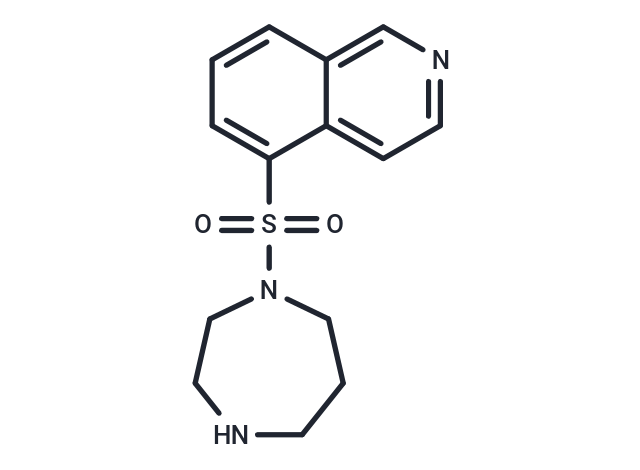Shopping Cart
- Remove All
 Your shopping cart is currently empty
Your shopping cart is currently empty
Fasudil (HA-1077) is a potent inhibitor of ROCK1, PKA, PKC, and MLCK.

| Pack Size | Price | Availability | Quantity |
|---|---|---|---|
| 50 mg | $33 | In Stock | |
| 100 mg | $45 | In Stock | |
| 200 mg | $62 | In Stock | |
| 500 mg | $107 | In Stock |
| Description | Fasudil (HA-1077) is a potent inhibitor of ROCK1, PKA, PKC, and MLCK. |
| Targets&IC50 | MLCK:55 μM(Ki), ROCK1:0.33 μM(Ki), PKC:9.3 μM(Ki), PKA:1.0 μM(Ki), PKG:1.65 μM, ROCK2:0.158 μM |
| In vitro | Fasudil (Hydrochloride) has vasodilatory action and occupies the adenine pocket of the ATP-binding site of the enzyme[1]. Fasudil is a class of calcium antagonists. Fasudil produces a competitive inhibition of the Ca2+-induced contraction of the depolarized rabbit aorta. Fasudil is able to inhibit contractile responses to KCl, phenylephnne (PHE) and prostaglandin (PG) F2a[2]. Fasudil also exhibits vasodilator actions by inhibition of 5-hydroxytryptamine, noradrenaline, histamine, angiotensin, and dopamine induced spiral strips contraction[3]. Fasudil induces disorganization of actin stress fiber and cell migration inhibition[4]. Fasudil inhibits hepatic stellate cells spreading, the formation of stress fibers, and expression of α-SMA with concomitant suppression of cell growth, but does not induce apoptosis. Fasudil suppresses the LPA-induced phosphorylation of ERK1/2, JNK and p38 MAPK[5]. |
| In vivo | Fasudil (30 μg) produces an approximate 50% increase in CBF via intra-coronary injection to dogs. Fasudil (0.01, 0.03, 0.1 and 0.3 mg/kg, bolus, i.v.) dose-dependently decreases MBP and increases HR, VBF, CBF, RBF, and FBF. A total dose of 1.0 ng/mL Fasudil increases cardiac output. The infusion of Fasudil i.v. produces a significant fall in MBP, left ventricular systolic pressure and total peripheral resistance with an increase in HR and cardiac output, but without significant changes in right atrial pressure, dP/dt or left ventricular minute work in dogs[3]. Fasudil administration displays protectable effects on cardiovascular disease and reduces the activation of JNK and attenuates mitochondrial-nuclear translocation of AIF under ischemic injury[6]. The oral administration of Fasudil (a dosage of 100 mg/kg/day) significantly reduces incidence and mean maximum clinical score of EAE in SJL/J mice immunized with PLP p139-151. Treatment of mice with Fasudil suppresses the proliferative response of splenocytes to the antigen. Oral administration of Fasudil decreases inflammation, demyelination, axonal loss and APP positivein spinal cord of Fasudil-treated mice[7]. |
| Kinase Assay | Cyclic AMP-dependent protein kinase activity is assayed in a reaction mixture containing, in a final volume of 0.2 mL, 50 mM Tris-HCl (pH 7.0), 10 mM magnesium acetate, 2 mM EGTA, 1 μM cyclic AMP or absence of cyclic AMP, 3.3 to 20 μM [r-32P] ATP (4×105 c.p.m.), 0.5 μg of the enzyme, 100 μg of histone H2B and compound. The mixture is incubated at 30°C for 5 min. The reaction is terminated by adding 1mL of ice-cold 20% trichloroacetic acid after adding 500 μg of bovine serum albumin as a carrier protein. The sample is centrifuged at 3000 r.p.m. for 15min, the pellet is resuspended in ice-cold 10% trichloro-acetic acid solution and the centrifugation-resuspension cycle is repeated three times. The final pellet is dissolved in 1 mL of 1 N NaOH and radioactivity is measured with a liquid scintillation counter[1]. |
| Synonyms | HA-1077, AT877 |
| Molecular Weight | 291.37 |
| Formula | C14H17N3O2S |
| Cas No. | 103745-39-7 |
| Smiles | O=S(=O)(N1CCCNCC1)c1cccc2cnccc12 |
| Relative Density. | 1.31g/cm3 |
| Storage | store at low temperature | Powder: -20°C for 3 years | In solvent: -80°C for 1 year | Shipping with blue ice/Shipping at ambient temperature. |
| Solubility Information | DMSO: Soluble |

Copyright © 2015-2025 TargetMol Chemicals Inc. All Rights Reserved.